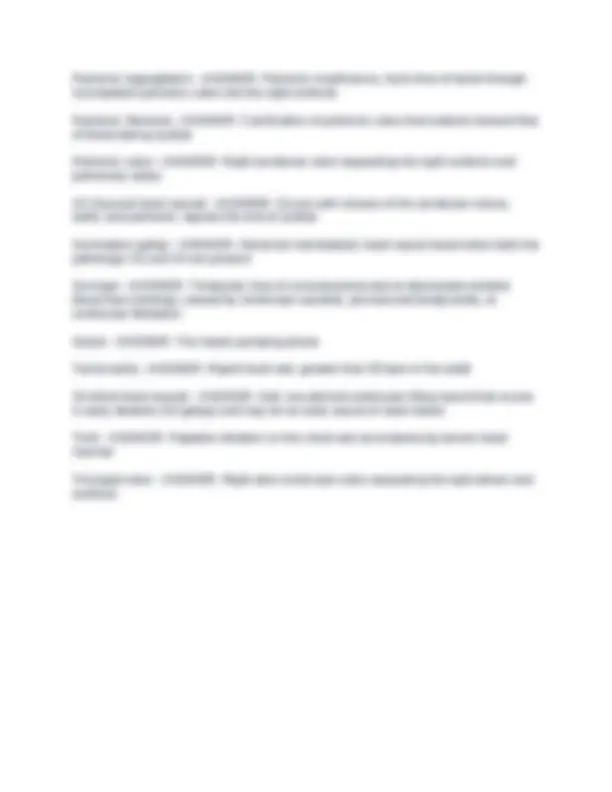



Study with the several resources on Docsity

Earn points by helping other students or get them with a premium plan


Prepare for your exams
Study with the several resources on Docsity

Earn points to download
Earn points by helping other students or get them with a premium plan
Community
Ask the community for help and clear up your study doubts
Discover the best universities in your country according to Docsity users
Free resources
Download our free guides on studying techniques, anxiety management strategies, and thesis advice from Docsity tutors
A comprehensive set of questions and answers related to the cardiovascular system, covering key concepts such as heart anatomy, physiology, and common cardiovascular conditions. It is a valuable resource for students studying human anatomy and physiology, particularly those preparing for exams or assessments.
Typology: Exams
1 / 3

This page cannot be seen from the preview
Don't miss anything!


Angina Pectoris - ANSWER- Acute chest pain that occurs when myocardial demand exceeds oxygen demand Aortic Regurgitation - ANSWER- (Aortic insufficiency) incompetent aortic valve that allows backward flow of blood into the left ventricle during diastole Aortic Stenosis - ANSWER- Calcification of aortic valve cusps that restricts forward flow of blood during systole Aortic valve - ANSWER- The left semilunar valve separating the left ventricle from the aorta Apex of the heart - ANSWER- Tip of the heart pointing downward toward the 5th intercostal space Apical impulse - ANSWER- Point of maximum impulse (PMI); pulsation created as the left ventricle rotates against the chest wall during systole, normally at the 5th left intercostal space in the midclavicular line Base of heart - ANSWER- Broader area of hearts outline located at the 3rd right and left intercostal space Bradycardia - ANSWER- Slow heart rate, less than 50 bpm in the adult Clubbing - ANSWER- Bulbous enlargement of distal phalanges of fingers and toes that occurs with chronic cyanotic heart and lung conditions Coarctation of Heart - ANSWER- Severe narrowing of the descending aorta, a congenital heart defect Cor Pulmonae - ANSWER- Right ventricular hypertrophy and heart failure due to pulmonary hypertension Cyanosis - ANSWER- Dusky blue mottling of the skin and mucous membranes due to excessive amount of reduced hemoglobin in the blood Diastole - ANSWER- The hearts filling phase Dyspnea - ANSWER- Difficult, labored breathing
Edema - ANSWER- Swelling of legs or dependent body part due to increased interstitial fluid Erbs point - ANSWER- Traditional auscultating area in the 3rd intercostal space S1 (First heart sound) - ANSWER- Occurs with closure of the atrioventricular valves signaling the beginning of systole S4 (Fourth heart sound) - ANSWER- S4 gallop, atrial gallop; very soft low pitched, ventricular filling sound that occurs in late diastole Gallop Rhythm - ANSWER- The addition of a 3rd or 4th heart sound; makes the rhythm sound like the canter of a galloping horse Inching - ANSWER- Technique of moving stethoscope incrementally across the precordium through the auscultatory area while listening to the heart sounds Left ventricular hypertrophy (LVH) - ANSWER- Increase in thickness of myocardial wall that occurs when the heart pumps against chronic outflow obstruction (aortic stenosis) Midclavicular line (MCL) - ANSWER- Imaginary ventricle line bisecting the middle of the clavicle in each hemothorax Mitral regurgitation - ANSWER- Mitral insufficiency, incompetent mitral valve allows regurgitation of blood back into the left atrium during systole Mitral stenosis - ANSWER- Calcified mitral valve impedes forward flow of blood into left ventricle during diastole Mitral valve - ANSWER- Left atrioventricular valve separating the left atrium and ventricle Palpitation - ANSWER- Uncomfortable awareness of rapid or irregular heart rate Paradoxical splitting - ANSWER- Opposite of a normal split S2 so that the spilt is heard in expiration, and in inspiration the sounds fuse to one sound Pericardial friction rub - ANSWER- High-pitched scratchy extra cardiac sound heard when the precordium is inflamed Physiologic splitting - ANSWER- Normal variation in S2 heard as two separate components during inspiration Precordium - ANSWER- Area of chest wall overlying the heart and great vessels